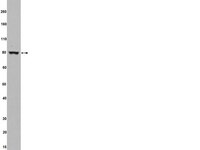IKKepsilon and TBK1 are essential components of the IRF3 signaling pathway.
Fitzgerald, Katherine A, et al.
Nat. Immunol., 4: 491-6 (2003)
2003
Afficher le résumé
The transcription factors interferon regulatory factor 3 (IRF3) and NF-kappaB are required for the expression of many genes involved in the innate immune response. Viral infection, or the binding of double-stranded RNA to Toll-like receptor 3, results in the coordinate activation of IRF3 and NF-kappaB. Activation of IRF3 requires signal-dependent phosphorylation, but little is known about the signaling pathway or kinases involved. Here we report that the noncanonical IkappaB kinase homologs, IkappaB kinase-epsilon (IKKepsilon) and TANK-binding kinase-1 (TBK1), which were previously implicated in NF-kappaB activation, are also essential components of the IRF3 signaling pathway. Thus, IKKepsilon and TBK1 have a pivotal role in coordinating the activation of IRF3 and NF-kappaB in the innate immune response. | 12692549
 |
Triggering the interferon antiviral response through an IKK-related pathway.
Sharma, Sonia, et al.
Science, 300: 1148-51 (2003)
2003
Afficher le résumé
Rapid induction of type I interferon expression, a central event in establishing the innate antiviral response, requires cooperative activation of numerous transcription factors. Although signaling pathways that activate the transcription factors nuclear factor kappaB and ATF-2/c-Jun have been well characterized, activation of the interferon regulatory factors IRF-3 and IRF-7 has remained a critical missing link in understanding interferon signaling. We report here that the IkappaB kinase (IKK)-related kinases IKKepsilon and TANK-binding kinase 1 are components of the virus-activated kinase that phosphorylate IRF-3 and IRF-7. These studies illustrate an essential role for an IKK-related kinase pathway in triggering the host antiviral response to viral infection. | 12702806
 |









